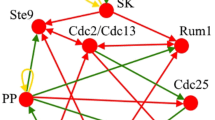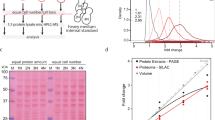Abstract
Fission yeast and budding yeast are the two distantly related species with common ancestors. Various studies have shown significant differences in metabolic networks and regulatory networks. Cell cycle regulatory proteins in both species have differences in structural as well as in functional organization. Orthologous proteins in cell cycle regulatory protein networks seem to play contemporary role in both species during the evolution but little is known about non-orthologous proteins. Here, we used system biology approach to compare topological parameters of orthologous and non-orthologous proteins to find their contributions during the evolution to make an efficient cell cycle regulation. Observed results have shown a significant role of non-orthologous proteins in fission yeast in maintaining the efficiency of cell cycle regulation with less number of proteins as compared to budding yeast.










Similar content being viewed by others
References
Fraser, H. B. (2005). Modularity and evolutionary constraint on proteins. Nature Genetics, 37(4), 351–352.
Han, J.-D. J., Bertin, N., Hao, T., Goldberg, D. S., Berriz, G. F., Zhang, L. V., et al. (2004). Evidence for dynamically organized modularity in the yeast protein–protein interaction network. Nature, 430(6995), 88–93.
Segal, E., Shapira, M., Regev, A., Pe’er, D., Botstein, D., Koller, D., et al. (2003). Module networks: Identifying regulatory modules and their condition-specific regulators from gene expression data. Nature Genetics, 34(2), 166–176.
Albert, R., Jeong, H., & Barabási, A.-L. (2000). Error and attack tolerance of complex networks. Nature, 406(6794), 378–382.
Podani, J., Oltvai, Z. N., Jeong, H., Tombor, B., Barabási, A.-L., & Szathmary, E. (2001). Comparable system-level organization of Archaea and Eukaryotes. Nature Genetics, 29(1), 54–56.
Milo, R., Shen-Orr, S., Itzkovitz, S., Kashtan, N., Chklovskii, D., & Alon, U. (2002). Network motifs: Simple building blocks of complex networks. Science Signaling, 298(5594), 824.
Shen-Orr, S. S., Milo, R., Mangan, S., & Alon, U. (2002). Network motifs in the transcriptional regulation network of Escherichia coli. Nature Genetics, 31(1), 64–68.
Cohen, O., Ashkenazy, H., Burstein, D., & Pupko, T. (2012). Uncovering the co-evolutionary network among prokaryotic genes. Bioinformatics, 28(18), i389–i394.
Adamic, L. A., & Huberman, B. A. (2000). Power-law distribution of the World Wide Web. Science, 287(5461), 2115.
Nacher, J., & Akutsu, T. (2007). Recent progress on the analysis of power-law features in complex cellular networks. Cell Biochemistry and Biophysics, 49(1), 37–47.
Barabási, A.-L., de Menezes, M. A., Balensiefer, S., & Brockman, J. (2004). Hot spots and universality in network dynamics. The European Physical Journal B, 38(2), 169–175.
Ravasz, E., Somera, A. L., Mongru, D. A., Oltvai, Z. N., & Barabási, A.-L. (2002). Hierarchical organization of modularity in metabolic networks. Science, 297(5586), 1551–1555.
Wagner, A. (2001). The yeast protein interaction network evolves rapidly and contains few redundant duplicate genes. Molecular Biology and Evolution, 18(7), 1283–1292.
Wagner, A. (1996). Genetic redundancy caused by gene duplications and its evolution in networks of transcriptional regulators. Biological Cybernetics, 74(6), 557–567.
Miyata, M., & Miyata, H. (1978). Relationship between extracellular enzymes and cell growth during the cell cycle of the fission yeast Schizosaccharomyces pombe: acid phosphatase. Journal of Bacteriology, 136(2), 558–564.
Fantes, P., & Nurse, P. (1977). Control of cell size at division in fission yeast by a growth-modulated size control over nuclear division. Experimental Cell Research, 107(2), 377–386.
Nurse, P. (1985). Yeast aids cancer research. Nature, 313(6004), 631.
Fantes, P. (1989). Yeast cell cycle. Current Opinion in Cell Biology, 1(2), 250.
Watts, D. J., & Strogatz, S. H. (1998). Collective dynamics of ‘small-world’ networks. Nature, 393(6684), 440–442.
Barabási, A.-L., & Albert, R. (1999). Emergence of scaling in random networks. Science, 286(5439), 509–512.
Author information
Authors and Affiliations
Corresponding author
Rights and permissions
About this article
Cite this article
Singh, P.K., Shakya, M. Comparative Evolutionary Analysis of Cell Cycle Proteins Networks in Fission and Budding Yeast. Cell Biochem Biophys 70, 1167–1175 (2014). https://doi.org/10.1007/s12013-014-0037-y
Published:
Issue Date:
DOI: https://doi.org/10.1007/s12013-014-0037-y




